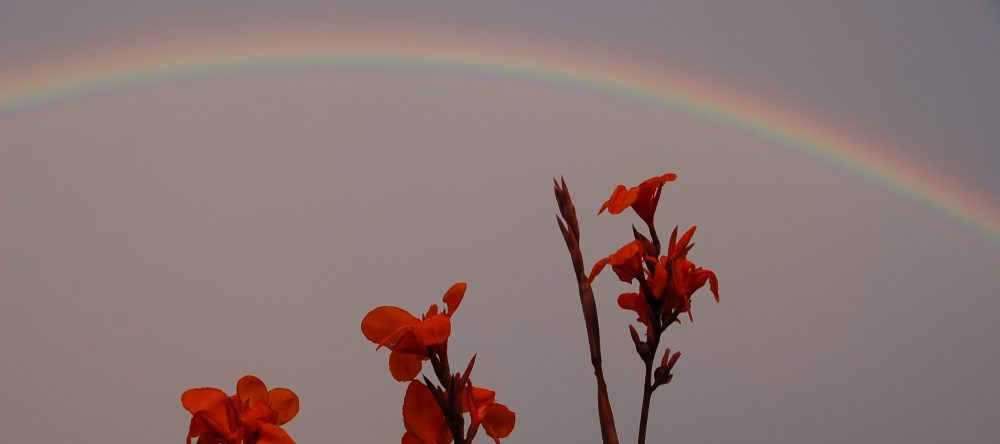
Most of the autumn colour in our garden is coming from plants in pots this year. This collection by the back door includes michaelmas daisies (Symphyotrichum ‘Audrey’, and ‘Climax’), a white hydrangea (Hydrangea paniculata ‘Limelight’) and a paperbark maple (Acer griseum).

The acer is a seedling from a large multi-stemmed specimen in the garden of one of my customers in South Wales. I remember that it produced a fantastic patchwork of reds and oranges in autumn. When they fell, the lawn became a magic carpet, and it looked so beautiful I was always reluctant to clear them (but had to, of course, or the grass would have been smothered). The acer will become the main focal point in the north east corner of the garden, where I’ve been clearing an old patio (this garden had far too much hard landscaping for my liking). I’m re-using materials for paths and patios, and yet I’m still having to go back and forth to the recycling centre with van loads of rubble.

I’m removing the paving slabs around the pond so that I can make a more natural edge. The water level in the pond never stays high for so long. I think it must be leaking, so I’ll need to empty it and fit a new liner. I’ll take the opportunity to make it a more natural shape. I also intend to create a few boggy areas, by putting perforated pond liner under the soil and allowing the pond to over-flow into these areas. I can then plant them up with moisture loving plants such as Rogersia, Ligularia, and Hosta.
The curse of the poisoned compost is still showing. Compare the canna below (which I think must have been potted into the poisoned compost) with the one at the top of this post. It’s half the size it should be, has produced no flowers this year, and the leaves are a sickly green, rather than the normal rich, dark colour.

Conversely, the rowan tree (Sorbus aucuparia ‘Eastern Promise’) which was planted in late winter, and which I didn’t think would make it, because it had so little root, did, and is showing superb colour…

Now that the dormant season’s here it can relax, gather its strength, and hopefully put on some growth next year. The beech hedge behind has done reasonably well, and hopefully that too will fill out somewhat next year.
The wildflower meadow in the front garden was sown earlier this year. It was slow to get going, but has established itself now . The Achilleas and the Silenes were particularly pretty. When we cut it back at the weekend there were still quite a few plants in full flower. After cutting it back, we planted some bulbs in the meadow. Species tulips are not tall but should (hopefully) flower before the meadow has taken off. Allium hollandicum ‘Purple Sensation’ flowers a bit later on, but has tall stems that should rise its purple spheres above the level of the meadow plants. Using cultivated, non-native plants in a wild-flower meadow might be seen as not quite the thing to do, but it’s gaining popularity, and if it looks good, and the non-natives you plant provide food and shelter for wildlife, why not?

Other plants that are still in pots (for now) and which have spectacular autumn leaf colour include Cotinus coggygria (an unknown cultivar)…

In the ground, this will make a very large shrub, with clouds of wispy flowers (hence the common name of smoke bush), but if you cut it back to just above ground level each spring, it will throw up long shoots with very large leaves. You miss out on the flowers, but the foliage is much more impressive than if left to do its own thing, and the plant doesn’t take up half your garden.
This Rhus typhina will probably have to stay in a pot, as sumachs have a tendency to throw out suckers, and can annexe large sections of your garden. This variety has delicate, intricate leaves that turn bright colours in autumn (as you can see). I think the dark-leaved dhalia (Dhalia ‘Bishop of Leicester’) sets it off well. It hasn’t been a good year for dhalias. The flower buds seem to form and then come to nothing. I suspect it’s down to the dreaded earwigs (more on that another time) which eat the flowers. I keep meaning to go out and look after dark to confirm this theory (but keep forgetting!)

In terms of remaining flower colour, the hardy fuchsias are in full swing now. This one is (I think) Fuchsia ‘Mrs Popple’…

The borage is still hanging on…

Rudbeckia fulgida var. sullivantii ‘Goldsturm’ (a bit of a mouthful!) is still in pots, waiting for me to get the borders fully prepared. This one was hosting a shield bug…

The marigolds were late starting, but are still looking good…

The nasturtiums haven’t thrived (despite the sandy soil) but are making something of a comeback now the cabbage white caterpillars have moved on…

The opium poppies self-seed around freely and have played a huge role in filling the gaps in a garden that would otherwise have been rather empty. Sometimes I wonder why I feel the need to buy plants when you can have flowers like these for free…

Last, but not least, these lilies (‘White Triumphator’) are doing their thing rather late, but are a welcome sight (they smell wonderful too)…

Text & photos © Graham Wright
